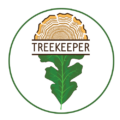Young Tree Training
Young Tree Training
Welcome to TREEKEEPER’s Young Tree Training Program, where we nurture the future of your green assets with precision and care. Central to our approach is the cultivation of a strong central leader in young trees, with smaller branches which are well-spaced & well-attached.
The goal is to use very specific pruning cuts on a young to middle-aged tree, in order to “subordinate” and slow down the relative growth rates of the tree’s lateral limbs, thereby forcing more growth into the main stem and dominant leader.
Over time, this results in sturdier branch architecture and a mature tree which moves as one during wind events, distributing mechanical stress along its entire trunk. This is opposed to having numerous “co-dominant” trunks which are less well-attached and move independently in the wind, focusing load stress at points prone to failure.
Our pruning also aims to slow the growth of low, temporary branches. The tree needs these low limbs while it’s young. But if we keep them small with pruning, then later we can gradually remove them in order to raise the canopy as necessary over traffic and infrastructure, without seriously injuring the tree.
If you start this kind of regular pruning on a newly planted tree when it’s still very small, you can do a whole lot of good with relatively minimal input. Over the long-term, this can result in a tree that lives longer, poses less risk to people and structures, is well-suited to its location, and requires significantly less maintenance in maturity.
Benefits of Young Tree training
Young tree structural training offers numerous benefits for both the trees and their surroundings:
- Improved Structural Integrity: Training young trees helps promote the development of a strong central leader with smaller, well-spaced branches. This spreads mechanical stress along the entire trunk rather than concentrating it at branch unions, reducing the risk of structural weaknesses and failure as the tree matures. By correcting defects while a tree is still small, we can avoid letting them become severely problematic for the tree when it grows larger.
- Space Optimization: Young tree training also helps maximize the available space in urban or confined environments. We use specific cuts to control the growth of low temporary branches, so that they can gradually be removed & the canopy raised above people and structures—without creating large, harmful wounds on the tree. We can also promote growth in certain directions and reduce it in others, helping to prevent spacial conflicts before they arise.
- Cost Savings: Investment in training young trees can ultimately save property owners money by reducing the need for corrective pruning & maintenance when the tree is larger, or potential tree removal and property damage due to structural defects or hazards.
- Enhanced Aesthetics & Value: By shaping the tree’s growth early on, structural training can create a more balanced and attractive canopy, enhancing the overall appearance of the tree and the surrounding landscape. An attractive tree which occupies its space well can add significant value to your property.
- Increased Lifespan: Young tree structural training sets the foundation for a sturdier & more resilient tree. This may extend its lifespan and help ensure its continued presence and benefits in the landscape for many years to come.
Overall, young tree structural training is a proactive and cost-effective strategy that yields numerous benefits for the long-term health, safety, and beauty of trees in the landscape.
